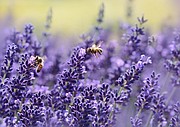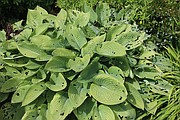Plan landscape with ‘deer-proof’ plants
Today’s readers will notice that I inserted quotation marks around the word deer-proof in the headline.
That’s because when all’s said and done, a hungry deer will eat just about anything. However, I’ve gleaned a list from several sources, some of which agree with each other, some offering species not included by others, and some unique ideas for those wishing to include plants beloved by deer in their landscape.
My sources come from “Montguide” (Montana State University Extension); “Guideline for Plants Damaged by Deer” (Cornell Cooperative Extension of Westchester Co.); “Deer Resistant Plants” (SpringHill Gardening News); and a variety of others including Master Gardeners from our local Bonner County/University of Idaho Extension service.
Lists are surprisingly long, giving hope for the control of our pretty but destructive deer population. They contain ornamental, shrubs, perennials, bulbs, vines and grasses.
First, I’ll offer a compilation of “never or rarely eaten by deer” that all three of our initial sources agreed upon, using common names as opposed to the longer Latin identification.
Asters, Astilbe, Bleeding Heart, Coral Bells, Coreopsis, Delphinium, English Daisies, Ferns, Gaillardia, Lamb’s Ears, Lavender, Liatris, Lupine, Monarda, Mums, Phlox, Poppies, Yarrow, Butterfly Bush, Dwarf Lilac, Forsythia, Dwarf Burning Bush, Trumpet Vine, Powder Blue Festuca, Tuberous Begonias, Daffodils, Iris, Muscari, Spider lilies (Tradescantia), Oregon Grape, Marguerites, Violets.
The secondary list — and in my experience, equally efficacious — includes the following:
Ajuga, Bishop’s Weed, Periwinkle, Alyssum, Veronica, Lamium, Lily-of-the-Valley, Pulmonaria, Coneflowers (Echinacea and Rudbeckia), Clematis, Honeysuckle, Wisteria, Foxglove, Berginia, Barberrys, Goldenrod, Columbine, Yarrow, Pinks, Joe-Pye Weed, Cranesbill Geranium, Candytuft, Hellebore, Osier Dogwood, Juniper, Syringa, Rugosa, Cranberry.
The third list, containing plants listed by only one source, includes not only some known deer dislikes overlooked by the others but some excellent considerations, including herbs.
Why these were left out of other lists, I have no idea, but I have long known that certain herbs are off-putting to deer, i.e., sage, rosemary, mints, basil, parsley, Pennyroyal, beebalm, chives, garlic, and onions.
Other such plants include Morning Glory, Forget-me-Not, Dusty Miller, Marigold, Anemone, Wormwood, Goatsbeard, Heather and Heath, Tussock Bellflower (low-growing Campanula), Painted and Shasta Daisys, Feverfew, Dianthus (Pinks and Sweet William), Sweet Cecily, Angelica, Evening Primrose, Primrose, Buttercup, Rhubarb, Scilla, Sweet Woodruff.
There are, of course, contradictions: One source named Sunflower as rarely eaten by deer, while another said it was “frequently” eaten. One named Ceanothus (deerbrush, snowbrush, wild lilac, etc.,) as deer-resistant and I know better since I have several on my property, visited regularly by deer and moose (which keep it pruned and growing nicely).
More important, perhaps, is knowing which plants deer LOVE, and these include Hosta, Lobelia, Daylily, Tulips, Crocus, Impatiens, tender roses like teas and English varieties, and many of the taller Campanulas.
The secret to success here is interplanting: Tulip and Crocus bulbs among the Daffodils/Narcissi; Liatris and Coral Bells among the Hostas (which I have done with great success) or consider mounds of Cranesbill Geranium; interspersing species Campanula with the low-growers such as “Blue Clips” and wild Harebell (Bluebell of Scotland), are all wise precautions.
Too, planting among groundcover (Periwinkle or Sweet Woodruff) will enhance the safety of at-risk Daylilys, fragrant Wood Hyacinth, Peonies, Sedum, and Meadow Rue, to name a few deer-tempters. Pansies can be protected by planting them among clumps of wild Violets. Add some Lily-of-the-Valley and/or Primroses for a sweet — and safe — “cottage garden” look. One important thing to remember in your garden planning is that natives are not only hardier but naturally deer-resistant. Also, selecting perennials that are hardy from Zone 3 is a practical safety precaution.
Select your favorites from today’s list, remembering our caveat about second-guessing a deer’s palate, taking some of the suggested precautions, and planning your landscape accordingly. It’s a fun and rewarding challenge!
•••
Sometimes, one particular plant will prove irresistible to a whole bunch of pests. So it is with the Hosta.
Beloved by deer, it also sends out a siren call to slugs and snails. The deer solution is addressed in today’s column. The slug/snail problem was not. I have found the perfect answer to this from the garden’s alive! catalog.
It’s an organic pellet called Escar-Go! that not only kills slugs and snails but earwigs, cutworms, sowbugs, pill bugs, crickets, and ants. I’ve used it for three years now, both at home in my extensive Hosta planting and for invading slugs at the Bonner General Hospital Healing Garden among the roses there.
Escar-Go! is a safe compound for everything but the targeted pests. Their motto is “Environmentally Responsible Products that Work!” Contact them at www.GardensAlive.com or by phone/fax at 513-354-1482. Note: Another pellet, called Slug-go, is available and does the job, but can prove dangerous for dogs, cats, and other pets as well as small woodland mammals. Since this is a consideration for me, I couldn’t use it. Field growers, however, could possibly make use of it.
(Editor’s note: For many years, Valle Novak has written gardening and cooking columns for the Daily Bee. “Weekend Gardener” and “Country Chef” became renowned for their humor, information, and common sense advice on how to do everything from planting to cooking. While she recently retired, she has shared a number of columns to delight her many fans. This is one such column and was originally published on Jan. 24, 2010.)







